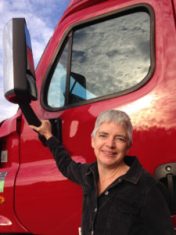Anne Balay: Trucking Gets Queerer
 Today we welcome a guest post from Anne Balay, author of Semi Queer: Inside the World of Gay, Trans, and Black Truck Drivers, originally published in 2018 by UNC Press.
Today we welcome a guest post from Anne Balay, author of Semi Queer: Inside the World of Gay, Trans, and Black Truck Drivers, originally published in 2018 by UNC Press.
Long-haul trucking is linked to almost every industry in America, yet somehow the working-class drivers behind big rigs remain largely hidden from public view. Gritty, inspiring, and often devastating oral histories of gay, transsexual, and minority truck drivers allow award-winning author Anne Balay to shed new light on the harsh realities of truckers’ lives behind the wheel. A licensed commercial truck driver herself, Balay discovers that, for people routinely subjected to prejudice, hatred, and violence in their hometowns and in the job market, trucking can provide an opportunity for safety, welcome isolation, and a chance to be themselves—even as the low-wage work is fraught with tightening regulations, constant surveillance, danger, and exploitation. The narratives of minority and queer truckers underscore the working-class struggle to earn a living while preserving one’s safety, dignity, and selfhood.
Semi Queer is now available in paperback for the first time.
###
Trucking Gets Queerer
Though the trucking industry is a consistent, stable backbone of America, and 18-wheelers continue to crisscross the country transporting everything we eat and wear and use much as they have for generations, at the same time trucking is experiencing a dizzying rate of change in the 21st century. My book Semi Queer takes pains to describe the web of regulations that shape a trucker’s day, including those of the Department of Transportation, the Megacarriers, the insurance industry, individual states. . . and these have continued to mount since the book was published. For example, in December of 2017 the ELD mandate went into effect. This is a Federal Rule imposed by the Federal Motor Carrier Safety Administration (FMCSA) that requires almost all trucks to switch from paper logs to an Electronic Logging Device to record their working hours. Many truck drivers fought this new rule, and protests were organized preceding its roll out . . . many drivers who had supported President Trump because of his stated opposition to government overstepping pressed him to intervene on their behalf . . . but none of this advocacy mattered and the new rule went into effect.
That was just over two years ago and the effects have been dramatic. Many trucks already had ELDs and nothing much changed for them. One thing that did change is that older engines were exempt from the ruling, so highways saw an increase in older rigs, many of which have no or limited pollution controls. Was this an unintended consequence? Steer Haulers and small fleets worked to maintain their loopholes. But bureaucracy marched on. Currently almost all trucks have ELDs activated, meaning that truckers’ driving hours are measured and controlled by a rigid, unforgiving technology. As a trucker approaches the end of their 11 hours allowed driving for a day, they need a workable plan of where to park because once they hit that mark they are in violation: ticketable, fireable, scared. And as they reach the end of the seventy hour drive clock (after which they need to “reset” = not drive for thirty-four consecutive hours), even if they are very close to home or to some other convenient location, if they run out of hours, they must stop there, and wait the clock out there. This kind of rigid scheduling, forced onto a job subject to the whims of weather, road construction, traffic, other people’s schedules, and mechanical problems, is simply a recipe for disaster. Since the ruling, trucker fatalities have soared. If you haven’t seen your family or slept in your own bed for months, and you have exactly one hour to cover the miles that stretch between you and that destination, you are pressed to drive in less than safe ways. That’s just the reality.
Increased regulations do not increase safety. Period.
However, as the risks of the job increase, and the pay decreases, more and more queer, trans, and non-white truckers enter the workforce. One of my book’s narrators called me from a truck stop in Utah. She had been in the truck stop bathroom at night, brushing her teeth, unwinding before going out to sleep in her truck. Suddenly, she realized that ALL the other women in that bathroom were, like her, trans. She laughed out loud, and they turned it into an informal support group.
Some recent reports claim that the number of women entering trucking has jumped by 68%. I can’t confirm these numbers anywhere, but I agree that there is a dramatic jump. But very few of these women make it past the first year. Training is worse than terrible, harassment is numbingly common, and leaving home is crushingly hard. But women keep doing it. Black women, unhoused women, transwomen, women who do not lack courage and toughness.
Trucking is shifting so rapidly it feels like a hurricane, which makes it hard to grab onto any aspect of it and take a stand. Nonetheless it’s increasingly clear that trucking is a queer issue. The LGBTQA+ movement, in its activist and advocacy choices, should fight for the rights of truckers and other invisible, low-status workers. We are dense on the ground in these jobs, which means both that we need support from those more able to influence policy, and that we have the courage, the humor, and the desperation to ignite change. The seeds of queer liberation are being sewn in a truck stop bathroom outside Salt Lake City.
###

Anne Balay is winner of the Lambda Literary Emerging Writers Award. She is an Independent Scholar living in Saint Louis and is the author of Steel Closets. Visit her website or follow her on Twitter.

You must be logged in to post a comment.